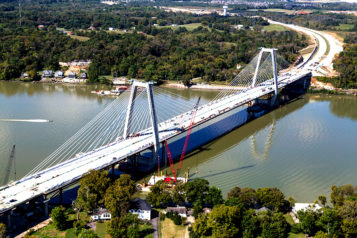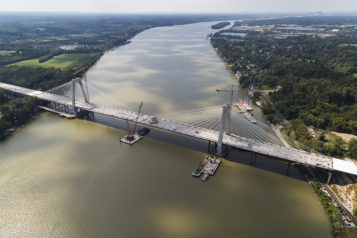
INDIANAPOLIS, In. – The Ohio River Bridges East End Crossing—which will connect the east end of Louisville, Kentucky, with Southern Indiana—recently earned an Envision Platinum Award from the Institute for Sustainable Infrastructure for the project’s exceptional achievements in sustainable infrastructure design, construction and operations.
The ORB EEC represents many Envision Award firsts, including the first project involving a highway, first river bridge, first bi-state project and first project with a roadway tunnel to receive an Envision Award. In addition, the $763-million public private partnership project—Indiana’s first for construction—is the largest P3 project in North America to be third-party certified by Envision’s horizontal infrastructure sustainability rating system.
“Strong teamwork and collaboration on sustainability aspects were in evidence throughout the project,” said Ron Heustis, project manager, Indiana Department of Transportation. “The innovative partnership between Indiana and the Commonwealth of Kentucky ensured the project was designed to serve the needs of the entire region today, and for the future. In fact, this is a project that serves as a sustainability best practice model that can be applied to other projects throughout the country.”
The state of Indiana—in cooperation with the Kentucky Transportation Cabinet—are collaborating to construct the ORB-EEC between State Road 265 in Indiana and the Gene Snyder Freeway in Kentucky, completing a loop around the east end of the Louisville metropolitan area. The project features a 2,300-foot-long cable stayed bridge with a pedestrian and bicycle path, 8 miles of new terrain highway and a 1,700-foot twin bore tunnel under a historic property. It is approximately half of the Louisville-Southern Indiana Ohio River Bridges Project—the largest bi-state transportation project ever undertaken by the two states—which also includes the Downtown Crossing connecting downtown Louisville and Jeffersonville, Indiana.
Three main firms are involved in delivering the ORB EEC project. WVB East End Partners, the Public-Private Partnership consortium comprised of Walsh Investors, VINCI Concessions and Bilfinger Project Investments International Holdings, is responsible for the operation, routine maintenance and rehabilitation of a substantial portion of the East End Crossing for 35 years. Walsh-VINCI Construction is WVB East End Partners’ Design-Build joint venture executing the work and consists of Walsh Construction and VINCI Construction.
The project, expected to take 3.5 years to construct, will be substantially complete in late 2016. Serving on the project since 1998, Parsons—as joint venture lead—is the general engineering consultant providing technical oversight services, including design review, construction management, as well as construction engineering and inspection. Parsons also assisted with the ORB-EEC P3 procurement.
Envision Awards are based on measures related to quality of life, leadership, resource allocation, natural world, as well as climate and risk. The project team’s sustainability priorities encompassed all these areas to achieve Platinum level, with the Envision Award judges giving their highest marks in three areas:
Quality of Life — By improving cross-river mobility, the EEC will stimulate the economy of the entire region, spurring business and job growth, increasing productivity and expanding the available workforce capable of commuting efficiently to their jobs. In addition, not only will traffic congestion in downtown Louisville be reduced, the project will expand the region’s capacity to accommodate anticipated population growth.
Leadership — Working within two states, the EEC team had to navigate differences in environmental laws and regulations, as well as transportation policies. Indiana and Kentucky quickly identified and mitigated any regulatory or policy impediments to achieving the highest levels of sustainability on the project, maintaining their spirit of cooperation for the benefit of the region.
In addition, throughout the project, hundreds of public meetings, workshops and design sessions were held, and stakeholder groups were formed to provide public input into the design, construction and operation of the EEC. Key outcomes of these meetings included measures to preserve historical properties and incorporate aesthetics design elements that align with the area’s history, including decorative fencing, lighting and pedestrian railings.
Climate and Risk — The EEC design included a minimum vertical alignment for the corridor to account for a 100-year flood event for the retaining walls and highway bridges, and a 500-year flood event for the tunnel, roadway and cable-stayed bridge. To address possible fires and earthquakes, a tunnel emergency response plan was implemented in cooperation with several local and state agencies, and the tunnel design exceeded seismic regulatory requirements.





 Join our thriving community of 70,000+ superintendents and trade professionals on LinkedIn!
Join our thriving community of 70,000+ superintendents and trade professionals on LinkedIn! Search our job board for your next opportunity, or post an opening within your company.
Search our job board for your next opportunity, or post an opening within your company. Subscribe to our monthly
Construction Superintendent eNewsletter and stay current.
Subscribe to our monthly
Construction Superintendent eNewsletter and stay current.